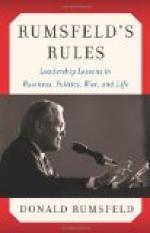There have long been signs that the Boer Power was subjected to a very great strain by the effort made to hold, against ever-increasing British forces, a number of points upon the circumference of a very large area. The Boers were attacking Mafeking and Kimberley, and covering their action at both points by forces intended to delay the relieving columns. They were also endeavouring to support rebellion throughout a great tract of country in the Cape Colony, extending from Prieska on the west to the Basuto border on the east, and covering the rebels by parties posted to resist the advance of Gatacre and French along the railways from the south coast to the Orange River. These two groups of enterprises were but the subordinate features of a campaign in which the principal undertaking was the reduction of Ladysmith, which involved a prolonged and stubborn resistance to the repeated assaults of Sir Redvers Buller.
Thus the Boer Governments, or their commander-in-chief, set out at the beginning to do many things at the same time. There were few British troops in the country, and there was the possibility of great success, at least in the shape of the occupation of territory, before the British forces could be assembled. But shortly after the arrival of Sir Redvers Buller’s Army Corps it began to be evident that the Boer forces were balanced by the British. There was a pause in the movements. The British made little headway and the Boers none. Yet, as both sides were doing their best, it was clear that the Boers required the utmost exertion of all their energies to maintain the equilibrium. This condition may be said to have lasted from about the middle of December to the middle of February. During those two months, however, while the Boers were at full tension, the British were gathering new forces behind their front line, which itself was all the time receiving gradual accessions of strength.
When Lord Roberts with fifty thousand men burst through the Boer cordon and destroyed the force with which Cronje had been covering the siege of Kimberley, the Boers had no reserve of force with which to fill up the gap. Every man sent to Cronje’s assistance had to be taken from some other post where he was sorely needed. The detachments sent from Natal into the Free State left the Natal Army, already wearied by its long unsuccessful siege of Ladysmith, and by Buller’s persistent attacks, too weak to continue at once the siege and the resistance to Buller. But the two tasks were inseparable, and when Buller renewed his attack and drove the Boers from their posts south of the Tugela, the Boer army of Natal found itself able to cover its retreat only by a last desperate rearguard action at Pieters.
Defeat in the Free State and collapse in Natal were accompanied by the abandonment of the effort to support the rebellion in Cape Colony.




